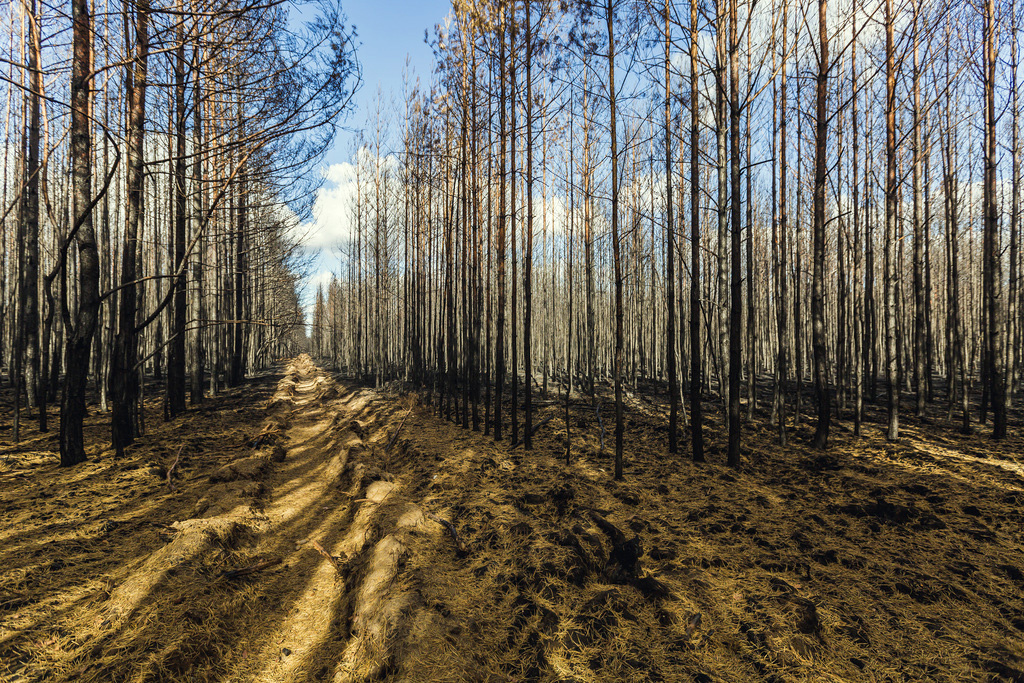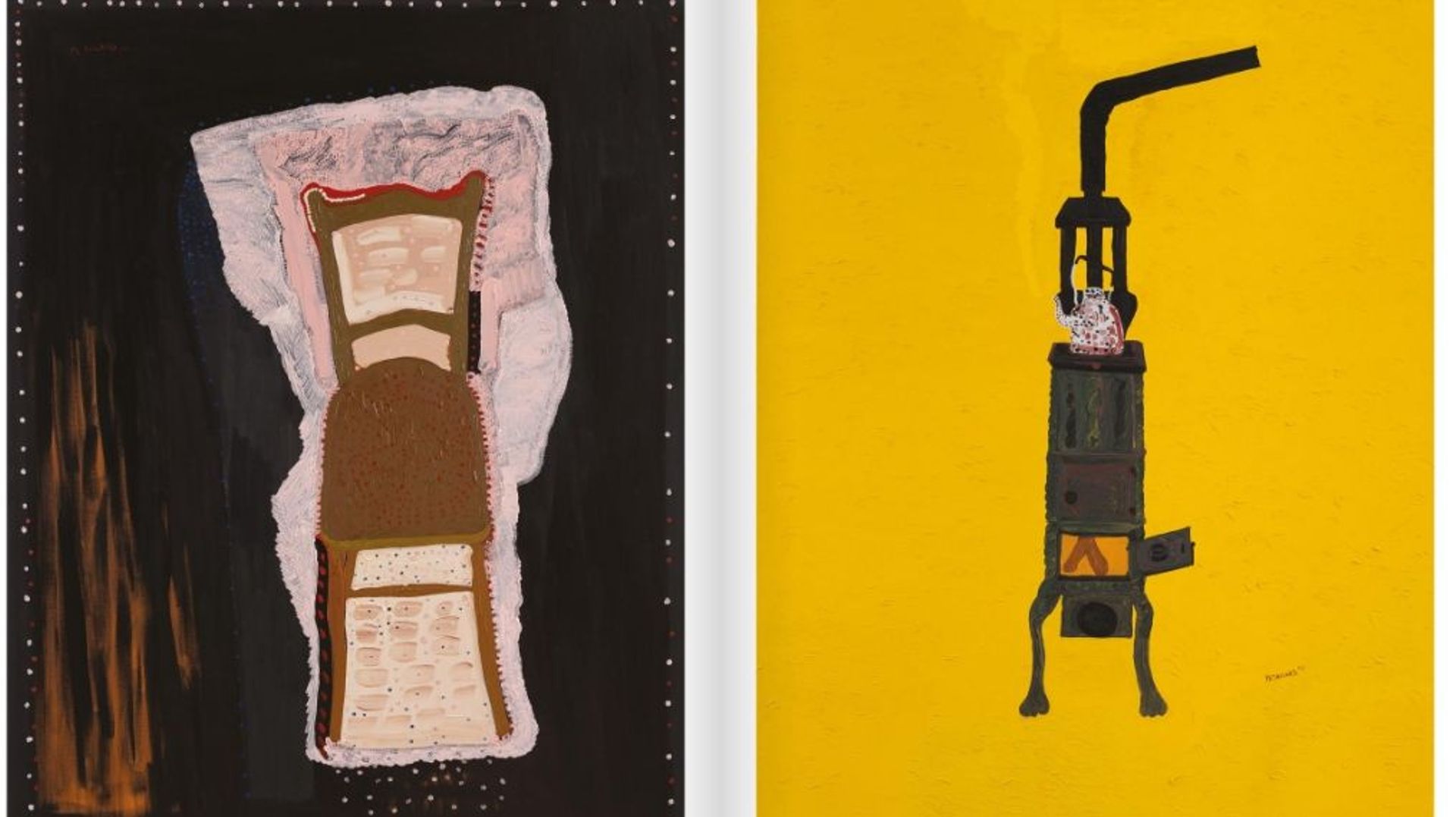
Switzerland’s forests of the future

Switzerland is planting exotic species from regions with drier climates to see how they adapt to warmer temperatures that will come with climate change. We went on site to see what the forests of the future will look like.
Peter Brang paces slowly through the forest of beech trees. It’s been more than a year since he was last here and on this warm spring day it’s not easy to find our way through the forest undergrowth. He is looking for a wire mesh attached to wooden posts: a fence he put up to mark his open-air laboratory. “Here we are,” says the expert in forest dynamics after walking a few minutes.
Inside the marked area, the towering larch trees that once populated the area have been cut down. Only a few scattered stumps remain. Lebanese cedars (Cedrus libani), a species of evergreen conifer native to the Middle East, have been planted instead. Some of the trees are three meters tall, while others are just up to our knees. One has died.

We are in Mutrux, a small commune in canton Vaud, in western Switzerland. HereExternal link, six exotic tree species from Turkey, Bulgaria and the United States were planted on a plot of about three hectares in 2012. It’s an example of what is called “assisted migration”. “We accelerated a movement of species that would otherwise have taken at least thousands of years,” explains Brang, a researcher at the Federal Research Institute for Forest, Snow and Landscape (WSL). There is nothing unusual in his experiment. Humans, he adds, have been intervening for centuries to shape forests according to their needs.
The introduced species were selected for their high resistance to drought and heat waves. Brang wants to study their growth and ability to survive in this new environment. “We want to know which trees could replace the species important to Switzerland that are suffering from climate change,” he says.
Global warming makes dry and hot periods in summer more frequent and intense, straining native tree species that evolved in a more temperate climate. The forest will not disappear, but it risks no longer being able to provide services that people depend on, such as protection from natural hazards or timber production, Brang says.

Robert Jenni, a scientific collaborator at the Federal Office for the Environment, who is accompanying us on the visit, clarifies that Switzerland’s strategy is not to replace native species, but to enrich the forest with exotic species. “The forest is a very resilient ecosystem. We want to give as many chances as possible to the species that already grow naturally and have a certain ability to adapt,” he says.
As part of another project,External link WSL and the Federal Office for the Environment are setting up a network of 57 experimental plantations throughout Switzerland. The aim is to study the climate tolerance of 18 tree species over a period of 30-50 years.
They include native species such as the silver fir and the larch as well as species from warmer regions such as the Constantinople hazel and the Douglas fir, which are meant to guarantee the performance of Swiss forests. A total of 55,000 saplings will be planted. The first results are expected in 2025.
A Turkish fir tree for Christmas?
We move to an area, where Turkish firs (Abies bornmuelleriana) have been planted. This conifer from the mountains of northern Turkey can tolerate long periods of drought and withstand temperatures as low as -18 degrees Celsius, making it an ideal substitute for Switzerland’s common firs or spruces. “One day, we may find it in our homes as a Christmas tree,” says Brang.
He explains that the species introduced to MutruxExternal link were selected based on ecological criteria and their economic value. They come from regions that have climate conditions that will likely prevail in Switzerland in the future. The foreign species don’t pose a threat to native ones and are so far resistant to pathogens, according to Brang.

The “luck” of the 2018 drought
The Mutrux experiment is part of an international project coordinated by the Bavarian State Institute of Forestry in Germany. The same exotic species from the same locations have been planted in five locations in Germany, Switzerland and Austria as part of this long-term experiment. “There aren’t many experiments like this internationally. Usually, you test different provenances of a single species,” says Brang.
A network of experimental sites makes it more likely that scientists will observe extreme events on at least one of them. Prolonged droughts and heat waves are of particular interest to researchers. The exceptionally hot, precipitation-free summer of 2018 was in this sense “a fluke,” Brang says. “Those involved in forest management will disagree with me, but I hope we get more of these kinds of events, as a stress test for the species.”
The summer of 2018 hit several European countries and was the third hottest in Switzerland since statistics began in 1864. The high temperatures reached 34°C between the end of July and mid-August, causing some 200 more heat-related deaths during that period than in a normal year. Water was scarce in many alpine areas, and the army had to secure water supply with helicopters. The drought caused severe losses to grass and fodder crops, and lowered the level of the Rhine River for an unusually long period, disrupting river transport of goods.
It also affected the forests and large trees, particularly the white spruce and beech varieties. In 10% of central European forests, trees prematurely lost some or all of their leaves, according to a WSL analysisExternal link. East-central Germany and the Czech Republic were hit the hardest. In Swiss mountains, where it was less hot and dry, the damage to forests was slightly less significant. But if such droughts recur, beech and fir trees may not be able to survive in the long term, according to the analysis.
Spruces suffer the most
Intense and repeated droughts dry out soils, increasing the annual mortality rates of all major European tree species by up to 60%, according to a large international studyExternal link not yet peer reviewed.
Without water, trees are more susceptible to pests and diseases. The risk of forest fires increases and the forest is no longer able to perform its essential functions which mainly include in mountainous areas protecting humans from avalanches, landslides and flooding. Over the next few decades, Brang predicts that there will be increasingly larger areas where those conditions can no longer be guaranteed, at least during certain periods. “That worries me,” he says.
Spruces, the most common trees in Switzerland, are particularly vulnerable. They have shallow roots which prevent them from searching deep for water during dry periods in the summer. The trees are less resistant to bark beetles, which prevent the flow of sap under the bark.

Timber industry looks for alternatives
With the decline of spruce, the forest industry risks losing one of the most sought-after tree species. Conifers provide two-thirds of the wood used in construction, furniture and energy production.
In 2020, Swiss forests provided 4.8 million cubic meters of wood. In comparison, in 2019, the Swedish furniture multinational Ikea used around 21 million cubic meters of round wood globally.
Thomas Lädrach, president of the umbrella organisation for the Swiss timber industry (Holzindustrie Schweiz), says that the sector will continue to use wood from conifers because hardwoods can only be used in construction under certain conditions. Alternatives to native spruces are therefore needed.
Among these are Douglas firs, which grow in the western coastal regions of North America. This conifer, which can reach a height of 57 metres, can withstand the summer heat well and is more resistant to drought than spruces and firs. It is not yet widespread in Switzerland but has shown it is sturdy, having rarely been attacked by bark beetles. Brang says that Douglas firs could ultimately make up 10% of Swiss forests in the future if they survive local conditions.
Cedar forests in Switzerland?
Then there’s the Lebanese cedar, one of the species that Brang is growing on the experimental plot in Mutrux. The strength of its wood is similar to, if not greater than, the commercial trees found in Swiss forests. It is a good candidate to replace spruce and Scots pine in construction, according to trade magazine BaublattExternal link.
But it is still too early to predict how well the species will acclimatise and grow in Switzerland. An initial assessmentExternal link was made in 2018, six years after the project began. In some species, high mortality was observed on all sites in Switzerland, Germany and Austria. Three out of four cedars, whose seedlings came from a Bavarian nursery, did not survive. “Apparently the species is very sensitive to desiccation during transplanting,” says Brang. “We didn’t know that.”
The saplings planted in a second phase grew slowly and remained small. They may have lost three to five years in their growth, says Brang, but that’s negligible in the century-long life of a tree. Most significantly, they don’t appear to have suffered unduly from the 2018 drought. “So far, there’s nothing to suggest that the species introduced here are not suitable for growing in our latitudes,” Brang says.
Above all, Brang doesn’t want to experience another nasty surprise, as he and other forest-watchers did with the black pine. Thirty years after it was successfully planted in Switzerland, its leaves were attacked by fungi and now the species is in decline. “That’s why it’s important not to come to conclusions prematurely,” he says. “Only in 50 or 100 years will we know if the trees we planted today are really resistant.”

In compliance with the JTI standards
More: SWI swissinfo.ch certified by the Journalism Trust Initiative
















![The four-metre-long painting "Sonntag der Bergbauern" [Sunday of the Mountain Farmers, 1923-24/26] had to be removed by a crane from the German Chancellery in Berlin for the exhibition in Bern.](https://www.swissinfo.ch/content/wp-content/uploads/sites/13/2025/12/01_Pressebild_KirchnerxKirchner.jpg?ver=ebf28c90)















You can find an overview of ongoing debates with our journalists here . Please join us!
If you want to start a conversation about a topic raised in this article or want to report factual errors, email us at english@swissinfo.ch.